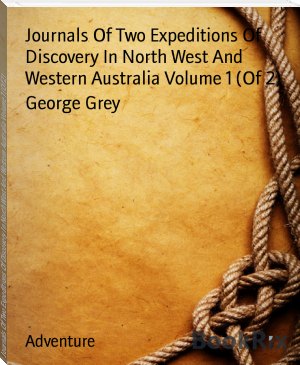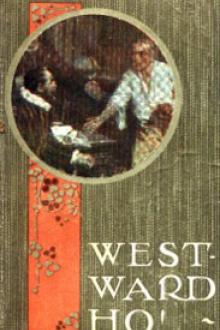Journals Of Two Expeditions Of Discovery In North West And Western Australia Volume 1 (Of 2) by George Grey (best ereader for pdf .txt) 📖

- Author: George Grey
Book online «Journals Of Two Expeditions Of Discovery In North West And Western Australia Volume 1 (Of 2) by George Grey (best ereader for pdf .txt) 📖». Author George Grey
Length Of Tentacula, 1.2 Inches.
Length Of Tail-Like Canal, 0.45 Inches.
Breadth, 1.1 Inches.
Thickness, 0.8 Inches.
Long Tentacula, Flesh-Coloured; Large Tentacula, Rose-Coloured; Lateral
Bags, Tinged With Clear Amber; The Rest Of The Animal Perfectly
Transparent.
We This Evening Caught Several Curious Little Animals (Clio ?) Which When
Taken Out Of The Water Appeared Like Small Balls Of The Same Matter As
That Of Which A Slug Is Composed. Presently A Little Head Peered Out,
Then The Body Expanded Itself, And Finally Two Little Things Like Wings
Were Spread Forth, Formed Of A Fine Membrane; They Moved These Very
Rapidly, And Swam With Great Velocity.
We Caught Several Small Crabs, And Two Kinds Of Shells, Of A Beautiful
Purple Colour. (Janthina Exigua.) These Were Very Small; I Have Preserved
Several Of Them.
Figures 1, 2, And 3 Represent Different Views Of An Animal (Salpa)
Slightly Electrical, That We Caught This Evening. Figure 1 Is Its
Appearance, One Side Being Up; Figure 2 When The Other Side Is Turned Up;
Figure 3 Is The Side View Of It.
I Have Never Before Seen One Of The Kind Electrical. Temperature The Same
As The Water, 65 Degrees Fahrenheit.
Length, 1.5 Inches.
Breadth, 0.6 Inches.
Thickness, 0.3 Inches.
Figure 1. The Intestinal Canal Terminates In A Little Coloured Bag,
Generally Of A Bluish Tinge; There Is An Opening At Each Extremity, One A
Little To The Left Of The Little Bag, The Other, As Shown In Figures 3
And 1.
November 13. Latitude 30 Degrees 7 Minutes South; Longitude 100 Degrees
50 Minutes 10 Seconds East.
Figure 1. Represents A Little Shell (Hyalea) Which Was Caught This Day.
Figure 2. One Of The Tentacula Of The Animal I Imagine To Be The
Physsophora Rosacea. The Point Which Is Seen Obtruding At The Base
Resembles A Little Nerve; It Runs The Whole Way Down The Tentacula.
Figure 3. A Little Shrimp-Like Animal (Erichthus Vitreus) Caught On The
14th November, Latitude 29 Degrees 26 Minutes South; Longitude 101
Degrees 32 Minutes East. Its Head Was Protected By A Shield, Such As Is
Shown In The Figure.
We Caught This Day Several Other Acalepha, Two Of Which Were Of The
Volume 1 Chapter 3 (From The Cape Of Good Hope To Hanover Bay) Pg 33Wonderful Genus Diphya. I Yesterday Drew A Coloured Figure Of The Lower
Part Of One Of These Animals.
This Animal In Its Perfect State (Such As We Found It In Today) Consists
Of Two Individuals, The Part Of One Being Encased In A Cavity Of The
Other. Figures 4 And 5 Illustration 4 Will Give A Correct Idea Of The Way
In Which This Junction Is Effected. The Least Motion Separates These Two
Parts, And Each Forms A Perfect Animal, Which Performs All The Functions
Of Life. This Is The More Extraordinary, As The Containing Animal Is
Furnished With An Organ Not Possessed By The Contained, And Which In
Their United State Is Used By Both. Figure 5. From The Little Bag (F) At
The Bottom Of The Cavity (G) The Receiver Produces A Chaplet, Which
Traverses The Canal In The Received Marked (2) In Figure 6, And Which Is
Here Drawn The Size Of Life, Was Sometimes Expanded To The Length Of One
Foot Eight Inches. This Organ, According To M. Cuvier, Is Composed Of
Ovaries, Tentacula, And Suckers.
The Swimming Apparatus, Marked (1) And (4) In Figure 6, Act
Simultaneously; They Are Of A Bright Amber Colour, And Their Mouth (A)
And (H) Are Closed With Little Valves, Nearly Invisible Even When In
Motion; The Points Round Their Upper Aperture Seem To Form The Hinges For
These. In Twenty Seconds I Counted Seventy Expansions And Dilatations Of
This Apparatus. The Chaplet And The Bag That Holds It Are Flesh-Coloured;
The Rest Of The Body Is Gelatinous And Diaphanous. They Live In Families,
And Swim With Great Rapidity In The Same Manner As The Other Acalepha.
Caught Also Shells And Crabs Of The Same Kind As Yesterday.
November 14. Latitude 29 Degrees 26 Minutes South; Longitude 101 Degrees
2 Minutes East.
Physsophora Rosacea, Cuvier, See Below. We Caught Another Animal Of The
Same Kind As The One Taken On The 12th Of November, And Figured In
Illustration 7. It Was So Delicate That I Did Not Measure It For Fear Of
Its Falling To Pieces, But It Appeared To Be Exactly The Same Size As The
Former One.
Its Circle Of Large Tentacula Were Of A Bright Pink, And Were Fifteen In
Number; Inside This Circle Was A Smaller One Of The Same Number Of
Shorter Tentacula, Which Were Not Quite So Bright A Pink Colour; In The
Centre Of These Were Placed Organs Of A Very Extraordinary Nature,
Apparently Quite Round, And Not Thicker Than The Very Finest Silk; They
Were Arranged Exactly In The Form Of A Corkscrew, And From The Beauty Of
Their Mechanism, The Animal Could Press Fold Against Fold, And Thus
Render Them Less Than A Quarter Of An Inch In Length, And I Watched It
Almost Instantaneously Expand Them To The Length Of Nine Inches. After
Having Observed The Animal Closely For An Hour I Am Writing This With It
Before Me, Alive In A Large Glass Bottle Of Salt Water, And Measuring
What I Put Down. The Manner In Which It Expands These Organs Is By First
Uncoiling Those Folds Nearest The Body, And Afterwards Those Most Remote;
So That When Folded Up It Looks Like A Corkscrew With The Folds Pressed
Volume 1 Chapter 3 (From The Cape Of Good Hope To Hanover Bay) Pg 34Close Together, And When Expanded, Like A Long Straight Thin Bit Of
Flesh-Coloured Silk, With A Little Corkscrew Of The Same Material At The
End. The Larger Tentacula Are Shaped Like The Trunk Of An Elephant, And
Their Extremity Is Furnished With A Very Delicate Organ With Which They
Can Catch Anything, And, If Touched, They Instantly Turn Some Of These
Tentacula, Which They Have The Power Of Moving In Any Direction, To The
Point So Touched. They Are Not Electrical: The Lateral Bags Have A Slight
Tinge Of A Bright Amber Colour. These Animals Sustain Themselves In The
Water By Means Of The Little Bag Marked (A) In The Figure, Which Floats
On The Surface Full Of Air, They There Swim In The Manner Before
Described. I Afterwards Observed Very Minute Globules, Or Lumps, In The
Long Silk-Like Tentacula. When Expanded These Were Very Distinct.
Latitude 29 Degrees 26 Minutes South; Longitude 101 Degrees 32 Minutes
East.
We Caught Several Small Shells (Janthina Exigua) This Afternoon:
Illustration 9 Represents One Of Them, With The String Of Air Bubbles
Attached, By Means Of Which They Swim On The Water. They Appear Not To Be
Able To Free Themselves From This Mass Of Bubbles: Every Shell I Have Yet
Found Floating In The Indian Ocean Possesses These Bubbles In A Greater
Or Less Degree; They Were Of A Purple Colour. I Have Seen The Common
Garden Snail In England Emit A Nearly Similar Consistency: They Also Emit
A Blue Or Purple Liquid, Which Colours Anything It Touches.
The Animals Of The Barnacles (Pentalasmis) Attached To These Shells
Assume Their Purple Colours, While The Shell Remains Nearly Pure White.
This Afternoon We Caught An Animal (Glaucus, Illustration 10) I Had Not
Before Seen. It Seemed To Represent The Order Reptilia In The Mollusca,
Being Sluggish In Movement, Its Eyes Distinct, Sensitive To The Touch,
Its Head Much Resembling A Lizard In Appearance, And Having A Very Strong
Unpleasant Smell When Taken Out Of The Water. During The Hour I Observed
It In A Bucket It Remained Sluggishly Floating On The Top, And
Occasionally Swimming By Moving Its Arms Slowly Along The Surface. The
First Three That I Saw Pass The Vessel I Imagined To Be Feathers Floating
On The Water.
Its Description Is As Follows:
Length From Head To Tail, A C 1.8 Inches.
Length From Head To Root Of Tail, A B 0.85 Inches.
Length From Head To First Arm 0.2 Inches.
Length From Head To Second Arm 0.45 Inches.
Length From Head To Third Arm 0.7 Inches.
1st Arm.
From Centre Of Back To End Of Round Part, D E 0.3 Inches.
From E To The End Of Short Tentacula, E F 0.3 Inches.
Ditto To Long Ditto, E G 0.75 Inches.
Diameter Of Round Part And Attached Tentacula 0.4 Inches.
Volume 1 Chapter 3 (From The Cape Of Good Hope To Hanover Bay) Pg 35
2nd Arm.
From Centre Of Back To End Of Tentacula. 0.4 Inches.
3rd Arm, Do. Do. 0.25 Inches.
Breadth Of Body Between The Two First Arms 0.13 Inches.
Thickness 0.25 Inches.
General Colour Of Body, Indigo Blue, Of A Darkish Tinge; Down The Centre
Of The Back A White Streak, Terminating At The Root Of The Tail; Sides
Blue, Tail Blue, Quite White Underneath, Its Belly Altogether Resembling
That Of A Frog; Tail Tapering To A Point.
1st Arm. 26 Tentacula Attached To The Rounded Paddle-Shaped Part Of This
Arm, The Centre Tentacle More Than Twice The Length Of The Others. These
Tentacula Were So Delicate That At The Slightest Touch They Fell Off.
Those Nearest The Body Were So Small As To Be Almost Imperceptible,
Gradually Increasing In Length As They Approach The Centre, And Then
Decreasing To The Other Side. Centre Of Paddle-Shaped Part White,
Tentacula Blue And White, Fringed With Dark Blue At The Extremity.
2nd Arm. 18 Tentacula To This, Centre Ones The Largest. Same Colour As
First Arm.
3rd Arm. 12 Tentacula, Not Forming Such A Regular Circle As On The Two
First Arms, And Apparently Issuing Directly From A Very Short Limb
Attached To The Body.
The General Appearance Of The Skin Was That Of A Frog. It Had The Power
Of Contracting Itself Considerably.
Caught
 Nowadays a big variety of genres are exist. In our electronic library you can choose any book that suits your mood, request and purpose. This website is full of free ebooks. Reading online is very popular and become mainstream. This website can provoke you to be smarter than anyone. You can read between work breaks, in public transport, in cafes over a cup of coffee and cheesecake.
Nowadays a big variety of genres are exist. In our electronic library you can choose any book that suits your mood, request and purpose. This website is full of free ebooks. Reading online is very popular and become mainstream. This website can provoke you to be smarter than anyone. You can read between work breaks, in public transport, in cafes over a cup of coffee and cheesecake.




Comments (0)